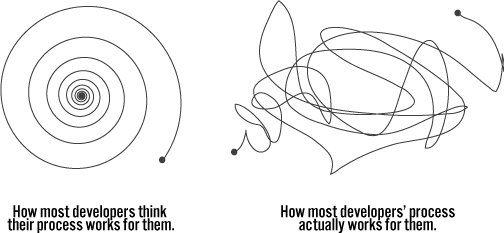The problem of organization
It's not that these tools and techniques are bad in themselves, but our use of each should be fit into a well tuned approach to building software. An entire project delivery should be tidy, professional, and complete.
There are a few causes to the problem of organizational buildup. Our software is limited, our methods need improvement, and the unseen pieces of our project pile up and are left a mess once we ship. categories: rants
TODO lists, project management software, and GTD all have the same basic problem. They push you to produce things that aren't your end goal, to help you improve your focus, thinking, and (in the end) produce better quality software in less time. These artifacts clutter your archives; the very things that help you create more effectively get in the way. They're a form of noise to your project's signal.
It's not that these tools and techniques are bad, but our use of each should be fit into a well tuned approach to building software. An entire project delivery should be useful, professional, and complete.
There are a few causes to the problem of organizational buildup. Our software is limited, our methods need improvement, and the unseen pieces of our project pile up and are left a mess once we ship.
Everything is a file
Our tools treat each of our artifacts as equal. They're generic, as there are many approaches to managing projects, so very few assumptions are made about the importance of each piece of the process. Requirements, specifications, prototypes, estimates, and development plans are strongly interrelated, but few tools are able to capture this.
Even the application structure of project management and software development tools re-enforce the everything-is-equal by placing features in tabs, sections, and tree nodes similarly. While it's easy to organize product features into tabs and tree nodes, it keeps them at the same level of importance by default and we have to work to tame the mess.
A polished specification is much more important than the research and prototypes that fed into it. A completed user interface design is superior to the sketches and feedback that improved it. Our tools, however, rarely help us focus on these differences.
Rushed and unfinished
Our own methodology—our process of analysis, design, and development—contributes to the chaos of project bits. We don't like to fund (or spend time) on things that aren't part of the output, so prototypes, design documents, and specifications remain unfinished and unpolished.

We also produce, and subsequently discard, various artifacts as we're learning the process of building better software. These forays into improvement leave a wake of debris that is unlikely to be used again. This is a failing of team management and individual process: we just don't put enough emphasis on picking successful tools or polishing and curating the prerequisites.
Projects need teams that have a winning approach. We should not be exploring process on project time (side quests are better for this), and hence the exploration and failure of various processes should be insulated from active work. Why practice at game time?
Cooks who cannot clean
Our tools should serve us better. Our own methodology should avoid processes that fail us. In the end, though, we shouldn't leave the mess behind. Each member should take pride in what we deliver, including the parts unseen: the designs, specifications, drawings, models, and all the supporting pieces.
Our methods and techniques are not unfortunate side effects in building software. They are what's involved in building software. We sketch, we design, we carefully consider each piece. These supporting activities are not lesser to writing code, they make writing code better.
Less is more
There are many great reasons to use better tools, to understand the process of building software, and to curate the entire effort. We know that it improves communication, reduces bug rates, and reduced project costs. We know that it makes for better software. And yet we end projects late, incomplete, insufficient, and in a mess.
Let go of the tools that do not work. Ignore the processes that are obvious losers. Obsess over ways of documenting design that take less time, and produce something useful. Learn to write better, make your sketches count, and don't leave a mess at any time. The thinking that goes into your software is the software.
Know how to build software. Sketch, document, and plan. Be proud of the method of building software, and curate the in-between steps. Spend time between projects improving your process; finding ways to do less and better. And above all, curate your thinking and the things you record your thinking with. What you produce will be better for it.